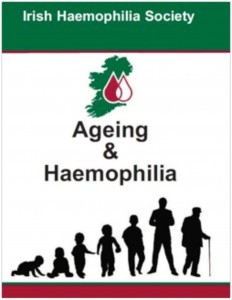Click on the image below to download a copy of the IHS publication Ageing & Haemophilia.
In the past, some studies from the USA and Netherlands had demonstrated a reduced risk of heart disease and cancer in person with haemophilia, with a Dutch study showing a reduced risk of ischemic heart disease (IHD) by 80%. However recent studies in Sweden and the USAhave shown no difference between the risk in people with haemophilia and the general population. It was a widely held view in the past that people with haemophilia had a lower risk of coronary heart disease, certainly those caused by clots because of the fact that the blood does not clot normally. However, we now have the first generation of people with haemophilia who are actually going to life long enough to experience diseases normally associated with ageing and the risks related to this will become clearer. Risk for heart disease include increased blood pressure, obesity, smoking and age. In some post mortem studies it was seen that people with haemophilia have the same risk as the normal population. Therefore it is quiet clear that having haemophilia does not give you a free pass on trying to ensure that you maintain normal blood pressure, avoid obesity and not smoke. There are of course further difficulties if people with haemophilia do develop heart disease which would normally necessitate treatment with Warfarin or anti-coagulant therapy. Giving anti-coagulant therapy to people with haemophilia is more complicated than with most individuals. A second presentation on heart disease and haemophilia referred to additional risk factors including increased lipids, diabetes and highly active anti-retroviral therapy (HAART) for HIV.
It was pointed out that over 80% of people with haemophilia with heart disease had more than 2 of the risk factors already mentioned. Dr. Gerry Dolan from Nottingham talked about a study in the UK which showed that 16% of people with severe haemophilia are now over 40 years of age. Centres see these patients at least once a year but sometimes up to 3 or 4 times a year if they have severe haemophilia. There needs to be a greater recording of the data on the physical activity of the people with haemophilia in addition to a formal cardiovascular risk assessment. 6 of the 17 centres in the UK carry out such risk assessment for people with severe haemophilia. Most of the treatment centres in the UK offer statins ( for lowering cholesterol, anti-hypertensive’s and lifestyle advice. Most haemophilia treatment centres in the UK if they diagnose a cardiovascular problem; they either manage it themselves or manage it with the assistance of a cardiologist. When they looked at the haemophilia population, 5% had high blood pressure, 5% were smokers and 1.4% had diabetes.
In relation to cancer, the main risks for men are cancer of the prostate, colorectal cancer, lung cancer or bladder cancer. Studies from theNetherlands and Germany showed an increased cancer risk in people with haemophilia, whereas a study in the UK showed no increased risk and no increase in risk was also seen in other studies from the USA, Canada andItaly. The screening test for bowel cancer is to test for occult blood and Dr. Dolan, wondered if this was done people with haemophilia. In relation to renal disease a UK study found an increased risk of renal or kidney disease in people with haemophilia- almost double the normal risk. This risk was associated with HIV, inhibitors or an increased blood pressure. In addition to haemophilic arthropathy, increasing age increases the risk of osteo-arthritis and rheumatoid arthritis. This would mean a requirement for increased physiotherapy and more work on balance and coordination. There is also a concern that with increasing age, the risk of inhibitors may increase. If you look at the inhibitor rate in older people with haemophilia in the UK, the number of cases of inhibitors per thousand patient years was 2.7 in those who were 30-39 years old and this increased to 4.96 in the 50-59 years old and 7.94 in the 60-69 years old. This showed a clear increase risk of inhibitors over the age of 50.
Haemophilic arthropathy is also a problem in the older population of people with haemophilia who did not have access to prophylaxis or even regular on-demand therapy when they were growing up. Most older people with haemophilia have multiple joint damage and often severe pain. There may often be a need for prophylaxis in older people with haemophilia and prophylaxis can increase the quality of life dramatically. One study in Italy of 54 adults with mean age of 30 (admittedly not very old) showed that the number of bleeds per annum decreased on average from 33 to 4 bleeds per annum, when one went from on-demand to prophylactic therapy and the days lost at work or college decreased from 35 to 4 per year. In other countries such as Denmark and Netherlandswhere young men have stopped prophylaxis at an average age of around 20-21years, they have not seen a dramatic impact in relation to their bleeding pattern but generally this is because those who have self selected to stop prophylaxis generally have a milder bleeding pattern. In relation to the additional risks from osteo-arthritis and rheumatoid arthritis, it is worth noting that bone mineral density can be reduced in people with haemophilia. In a German study of 62 people with haemophilia, only one third had normal bone density and a US study inArizona of 30 people with haemophilia only one third had normal bone density.
We are very fortunate that for the first time we have a population of people with Haemophilia in developed countries such as Ireland, who are going to have to confront the challenges of ageing. The normal challenges of ageing for men include the risk of heart disease, cancer, kidney disease and osteo-arthritis. Some of these risks can be increased or exacerbated in people with haemophilia by their haemophilia and by their co-morbidities including existing arthritis, HIV and/or Hepatitis C. It is a well recognised phenomenon that men generally do not like going to doctors and do not engage at a sufficient level with doctors in relation to preventative health. This is probably not the case in people with haemophilia who are used to visiting their haemophilia treatment centres and who have in the vast majority of cases have developed long standing relationships with healthcare professionals whom they trust.
For this reason, it is very important that the existing comprehensive care haemophilia treatment centres look at integrating into their comprehensive care services for haemophilia the screening and testing required to prevent and manage the diseases of ageing in the haemophilia population. In reality this may well mean that there would be a requirement for haemophilia treatment centres to integrate into their normal screening for people with haemophilia tests for cardiac disease, cancer, renal disease and arthritis in addition to the routine tests for factor levels, inhibitors and other specific tests relating to haemophilia. Centres may need to consider monitoring blood pressure, lipid profile including LDL and HDL cholesterol, blood glucose (for Diabetes), testing for protein in the urine (renal disease), prostrate specific antigen ( for prostate cancer), faecal occult blood ( for bowel cancer) and dual energy X-ray absorptimetry to check bone mineral density. A cardiologist may need to be added to the comprehensive care team as people with severe haemophilia over a certain age should have access to a comprehensive cardiovascular risk assessment. Additional complications of haemophilia on treatment and management of cardiovascular and other diseases of ageing are substantial and should be avoided where possible. It would be an excellent use of resources to prevent the development of these diseases if at all possible by screening, testing and by giving on going lifestyle advice including management of weight, body mass index and cessation of smoking.
Brian O\’Mahony
Click here to view the WFH publication The Challenge of an Ageing Hemophilic Population

